
Siquijor, officially the Province of Siquijor, is an island province in the Philippines located in the Central Visayas region. Its capital is the municipality also named Siquijor. To the north of Siquijor is Cebu, to the west is Negros, northeast is Bohol, and to the south, across the Bohol Sea, is Mindanao.
Didicas Volcano is an active volcanic island in the province of Cagayan in northern Philippines. The island, which was a submarine volcano and re-emerged from the sea in 1952, is 22 kilometres (14 mi) NE of Camiguin Island, one of the Babuyan Islands in Luzon Strait. Before 1952, the volcano first breached the ocean surface in 1857.
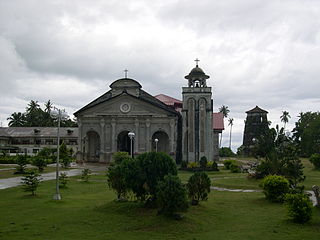
Panglao, officially the Municipality of Panglao, is a 4th class municipality in the province of Bohol, Philippines. According to the 2020 census, it has a population of 39,839 people.

Holocentridae is a family of ray-finned fish, the only family of the order Holocentriformes. The members of the subfamily Holocentrinae are typically known as squirrelfish, while the members of Myripristinae typically are known as soldierfish. In Hawaii, they are known by the Japanese name mempachi/menpachi (メンパチ) or the Hawaiian ʻūʻū.

The Borodino-class battleships were a group of five pre-dreadnought battleships built for the Imperial Russian Navy around the end of the 19th century. Their design was based on that of the French-built Tsesarevich modified to use Russian equipment. The first four ships were finished after the start of the Russo-Japanese War of 1904–1905 and were among the ships ordered to sail from the Baltic Sea to the Far East to relieve the Pacific Squadron besieged by the Japanese in Port Arthur. Three of these ships were sunk and one was captured by the Imperial Japanese Navy at the Battle of Tsushima in 1905. The fifth and final ship, Slava, was not completed in time to participate in the war and served with the Baltic Fleet through World War I.
Camiguin de Babuyanes is an active stratovolcano on Camiguin Island, part of the Babuyan Islands group that is located in Luzon Strait, north of the island of Luzon, in the Philippines. The volcano and the island are within the jurisdiction of the municipality of Calayan, in the province of Cagayan. The island has a population of 5,231 people in 2020.

Sargocentron is a genus of squirrelfish found in tropical parts of the Indian, Pacific and Atlantic Oceans, with the greatest species diversity near reefs in the Indo-Pacific. Being largely or entirely nocturnal, they have relatively large eyes. Red and silvery colours dominate. The preopercle spines are venomous and can give painful wounds. Most have a maximum length of 15–25 cm (6–10 in), but S. iota barely reaches 8 cm (3 in), and S. spiniferum can reach more than 50 cm (20 in).

Myripristis is a genus of soldierfishes.

The OJSC Baltic Shipyard is one of the oldest shipyards in Russia and is part of United Shipbuilding Corporation today.

The marine wildlife of Baa Atoll consists of marine species living in a circular archipelago in the Maldives, inside the administrative division of Baa Atoll, which is the southern part of Maalhosmadulu Atoll. Baa Atoll was named a biosphere reserve by UNESCO in 2011.
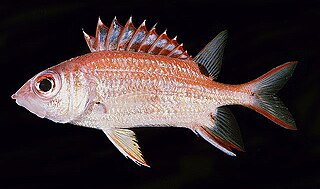
Sargocentron melanospilos, the blackbotch squirrelfish, is a species of squirrelfish in the genus of Sargocentron. It is found in the Indo-Pacific region in the Red Sea; Zanzibar, Tanzania; from Aldabra and Seychelles to the Marshall Islands and American Samoa; north to Taiwan, southern Japan and the Ogasawara Islands, and south to the southern Great Barrier Reef and the Chesterfield Islands. It is a relatively uncommon inhabitant of rocky reefs and coral-rich areas, and is usually seen solitary, but it also forms schools when in deeper water or oceanic areas.
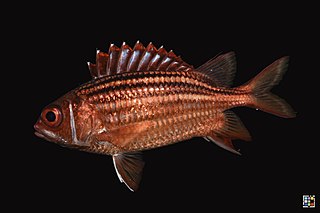
Sargocentron ittodai, the samurai squirrelfish, is a nocturnal species of squirrelfish belonging to the genus of Sargocentron. It is found in the Indo-Pacific region, in the Red Sea and Natal, from South Africa to the Marquesan Islands, and north from Southern Japan and the Ogasawara Islands, south to New South Wales, Australia. It inhabits outer reef slopes. It can be found either solitary or in groups. It mainly feeds on benthic crabs and shrimps.
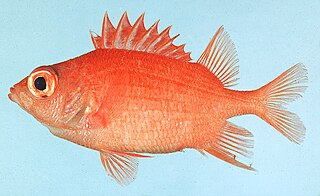
Sargocentron macrosquamis, the big-scale squirrelfish, is a species of squirrelfish belonging to the genus of Sargocentron. It can be found in the Western Indian Ocean, from the Red Sea to Mozambique, and in Seychelles, Maldives and the Chagos Islands.

Sargocentron marisrubri is a species of squirrelfish belonging to the genus of Sargocentron. It can be found in the West Indian Ocean in Egypt in the Gulf of Aqaba, also known as the Gulf of Elat, and in Sudan. It can be found in reefs in small aggregations.
Sargocentron poco, the saddle squirrelfish, is a species of squirrelfish belonging to the genus of Sargocentron. It is found in the Western Central Atlantic Ocean from the United States to the Cayman Islands, and in the Bahamas. It may also possibly be found in Cuba. It is likely to be more commonly found inhabiting shelf-edge reefs.
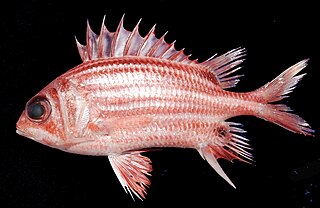
Sargocentron praslin, the dark-striped squirrelfish, is a species of squirrelfish beloging to the genus Sargocentron. It can be found in the Indian Ocean and the West Pacific Ocean, from East Africa south to Mozambique and east to the Marshall Islands excluding the northern Marshall Islands and the Society Islands. It has also been introduced into Libya, Turkey and Cyprus and may also possibly be found in Egypt and Greece. It inhabits reef flats and shallow protected reefs, often in dead reef areas. It is secretive during the day.

Sargocentron suborbitale, the tinsel squirrelfish, is a species of squirrelfish belonging to the genus Sargocentron. It can be found in the East Pacific Ocean from the Gulf of California to Ecuador including the Galapagos Islands. During the day, adults of the species hide in small caves or crevices of rocks. During the night, they feed on small crustaceans in the intertidal zone. It is oviparous.

Sargocentron tiereoides, the pink squirrelfish, is a species of squirrelfish belonging to the genus Sargocentron. It can be found in the Indian Ocean and the Pacific Ocean, from East Africa to the Line and Society Islands, north to Ryukyu, Japan and Wake Island, south to Vanuatu, through Micronesia. It inhabits outer reef slopes of deeper waters and has been collected on reef flat and lagoon patch reefs. It feeds on benthic crabs and shrimp at night.

Sargocentron violaceum, the violet squirrelfish, is a nocturnal species of squirrelfish in the genus Sargocentron. It can be found in the Indian Ocean and the Pacific Ocean from Aldabra and the Laccadive Islands to the Society Islands, north to Ryukyu, Japan, south to the southern Great Barrier Reef, and from Palau to the eastern Caroline and Marshall Islands in Micronesia. It is an uncommon inhabitant atoll reef flats, lagoon patch reefs, and steep outer reef slopes. It is a solitary and secretive species and can occasionally be seen in small crevices in clear water habitats. It is usually among rich coral growth and it mainly feeds on benthic crabs and shrimps.
Myripristis xanthacra, the yellowtip soldierfish, is a species of soldierfish belonging to the genus Myripristis. It can be found in the Western Indian Ocean in the southern half of the Red Sea and in Djibouti in the Gulf of Aden. It inhabits reef flats and slopes at depths below 18m.















